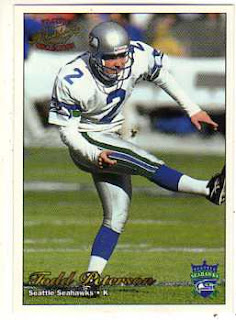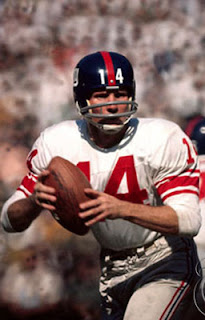The Cleveland Browns and San Francisco 49ers were formed as part of
the All-America Football Conference in 1946 and became fierce rivals during the
league’s four-year existence. The Browns were the dominant team, winning the
AAFC title in each season, while the 49ers were the second-best club, toiling
in the same division as Cleveland
for the first three years and, when the league did away with divisions in 1949,
they met in the Championship game. Both were absorbed into the NFL in 1950,
although the results in that first season were very different: Cleveland continued to be a dominant club,
winning the league title, while the 49ers sank to 3-9. The clubs met late in
the year in Cleveland
and the Browns won handily.
On September 30, 1951 the Browns took on the 49ers in the
opening week of their second NFL season. Games between the two teams had
typically been big draws during the AAFC years, and there were 52,219 in
attendance at Kezar Stadium.
The Browns were a star-studded club under the direction of
innovative Head Coach Paul Brown. Players like QB Otto Graham, ends Dante
Lavelli and Mac Speedie, and OT/PK Lou Groza were well-established performers
and used to winning. Cleveland
had some injury problems as well coming into the opening game, and they were without
DT Chubby Grigg and LB Hal Herring.
Some rain fell, mainly during halftime, and it certainly
appeared gloomy for the home crowd when Cleveland
scored quickly in the first quarter, going 89 yards in just three plays. Graham
threw short passes to Speedie and Lavelli before connecting with HB Dub Jones
near the sideline, who ran untouched to the end zone to complete the 81-yard
play.
The 49ers responded with a 49-yard drive in 13 plays that
ended at the Cleveland
one, where HB Verl Lillywhite was stopped short on fourth down. However, the
Browns were unable to move offensively and San Francisco got the ball back in good field
position following a punt by Horace Gillom. The 49ers tied the score, going 41
yards in just two plays. HB Pete Schabarum, subbing for the injured
Strzykalski, ran for 16 yards and then Frankie Albert connected with rookie end
Billy Wilson for a 25-yard TD.
Gordie Soltau missed on a 38-yard field goal attempt during
the second quarter when the 49ers lost ground after reaching the Cleveland 16. Lou Groza
also failed on a 42-yard field goal attempt for the Browns. With time running
out in the half, Albert moved the Niners from their own 40 to the Cleveland 34 and Soltau
was successful from 42 yards with two seconds left on the clock. The 49ers went
into the intermission with a 10-7 lead. The Browns lost another starter during
the second quarter when LB Tony Adamle suffered an ankle injury.
Early in the third quarter, Groza missed a 37-yard field
goal attempt that would have tied the score. When the Browns got the ball
again, Graham was intercepted in 49er territory by LB Norm Standlee, and he
returned it to his own 29. The 49ers proceeded to drive 71 yards, highlighted
by a 34-yard run by Lillywhite that followed a 15-yard sack of Albert by
Cleveland DE Len Ford, and ending with a six-yard touchdown carry by Joe Perry.
Groza finally was successful on a 40-yard field goal try, but the Browns were
down by 17-10 after three quarters.
There was some controversy in the fourth quarter when San
Francisco LB Pete Wisman intercepted a Graham pass, fumbled on the return, and
recovered at the Cleveland
8. The Browns questioned whether Wisman had regained possession. Perry followed
up with another six-yard scoring run to clinch the contest by a final score of
24-10. It was the first time the Browns had ever lost a season-opening game.
The 49ers outgained Cleveland
by 344 yards to 227, with 236 of that total via rushing while the Browns were
held to 55 yards on the ground. San Francisco also led in first downs by 18 to
11, although the 49ers turned the ball over four times against two suffered by
Cleveland.
Verl Lillywhite had a big day running the ball for the 49ers,
gaining 145 yards on 17 carries that included several runs for significant
yardage.
Meanwhile, Otto Graham, under a heavy rush for most of the
game, completed 18 of 30 passes for 222 yards and a TD but gave up the two
interceptions that led to scores and was also sacked six times. The
normally-reliable Lou Groza was successful on just one of four field goal
attempts. On the upside, Dub Jones (pictured below), thanks to the long scoring reception early
in the game, gained 143 yards on 5 catches.
Buck Shaw described the contest as San Francisco ’s “greatest game, even better
than the 56-28 rout of the Browns two years ago.”
Paul Brown refused to speak to reporters after the game and
locked the door to the locker room before speaking to his players.
While eyebrows were raised around the league regarding Cleveland ’s defeat, it
did not prove to be a sign of decline. The Browns didn’t lose another regular
season contest, going 11-1 to again top the American Conference and return to
the NFL title game. However, their title-winning streak spanning five years in
two leagues finally came to an end as they lost to the Rams for the league
championship.
The opening victory for the 49ers was followed by
alternating wins and losses until, after a tie in their ninth game, they
finished strong with three straight wins to end up in a tie for second in the National Conference with Detroit at 7-4-1. By that
point, Frankie Albert had been supplanted by Y.A. Tittle as the starting
quarterback, with favorable results.
Verl Lillywhite, who saw action in the defensive backfield
as well as at halfback, ended up rushing for 397 yards on 67 carries for a very
healthy 5.9-yard average. Joe Perry, as usual, led the club in rushing with 677
yards on 133 attempts (5.0 avg.). Billy Wilson, who scored in his first regular
season game for the 49ers, caught 18 passes for 268 yards (14.9 avg.) and three
touchdowns overall. It was a preview of much bigger years to come.
Otto Graham recovered to have another All-Pro year, throwing
for 2205 yards and 17 touchdowns while averaging 8.3 yards per pass attempt
with a completion percentage of 55.5 – all second-ranking figures in the NFL.
Dub Jones continued to be an effective receiver out of the backfield, catching
30 passes for 570 yards (19.0 avg.) and five touchdowns to go along with his
team-leading 492 rushing yards on 104 attempts (4.7 avg.) and seven TDs. Along
with Graham, he was a consensus first-team All-NFL and Pro Bowl selection.



















